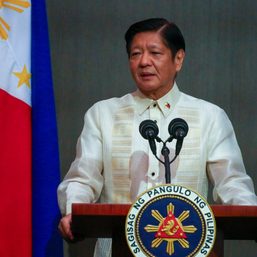SUMMARY
This is AI generated summarization, which may have errors. For context, always refer to the full article.
![[Rappler’s Best] Divided we fall](https://www.rappler.com/tachyon/2024/06/Divided-we-fall.jpg)
In case you missed it, Vladimir Putin was in the neighborhood – driving a limousine with North Korea’s Kim Jong-un, signing a military pact with the rogue state, and then flying to Hanoi, where he earned lavish praise from its communist leaders.
That’s enough to rattle an already-rattled region that, early in June, played host to Putin’s nemesis, whose country he has invaded in brutal precision: Ukraine President Volodymyr Zelenskyy. Add to this the spears and knives that the Chinese wielded at sea last week, as they punctured Philippine boats that were already moored beside BRP Sierra Madre, in Ayungin Shoal, for their resupply mission.
Anxiety has hit the roof in this part of the world. It’s palpable in the way action and language have played out in the last few days.
- On Friday, June 21, Malacañang suddenly called for a press conference where two officials who were remotely identified with the West Philippine Sea (WPS) issue said they had recommended to the President a policy shift: that all resupply missions to BRP Sierra Madre shall henceforth be announced. Information on these missions, including the latest one where China towed and rammed Philippine vessels, used to be on a need-to-know basis in government.
- It was Executive Secretary Lucas Bersamin and retired army general Andres Centino who faced the Malacañang Press Corps that Friday, looking and sounding like fresh troops deployed to a new terrain. They stressed that China’s aggression on June 17 did not constitute an “armed attack,” a prerequisite for the Philippines-United States Mutual Defense Treaty to be invoked.
- Until Friday, Bersamin and Centino had not been the authoritative voice on the WPS. Bersamin is the chair of the newly formed National Maritime Council while Centino is the presidential adviser on maritime affairs, who leads the council’s secretariat. The council is mandated to craft coherent policies to boost the country’s maritime security. Read about it in this story.
- Before China’s escalatory actions last week, it was the National Task Force for the WPS (NTF-WPS), tasked to “orchestrate, synchronize, and operationalize” the deployment of personnel and resources in the WPS, that was at the forefront of informing the public about activities in the area, such as the resupply missions.
- But even the loquacious task force spokesperson, Commodore Jay Tarriela, was measured in his words this time around, cautioning Filipinos against calling the June 17 incident an armed attack.
- Government’s decision to classify it as a mere “misunderstanding” between both countries, according to maritime law expert Jay Batongbacal, was likely meant to “give space for deliberate effort to seek a diplomatic and peaceful solution.”
- In a joint statement also on Friday, major business groups condemned China’s attack even as they called for a “non-violent” resolution to the conflict.
But lest we forget: the Marcos government acted like deer in the headlights after the ramming and towing of Philippine vessels on their way to Ayungin Shoal on June 17. Ironically, it was the two superpowers – China and the US – that fired the first volley of information, and accusations, regarding what happened in Philippine territory.
- Early morning of June 17, the Chinese Coast Guard said the Philippines bumped its vessels at Ayungin Shoal.
- Pentagon officials then leaked the news to a US website that a Filipino sailor was “severely” hurt during the incident.
- Philippine officialdom froze in silence for a dozen hours before it could muster a statement, as Rappler’s defense and foreign affairs reporter Bea Cupin illustrates in this story. What a contrast from the Philippines’ blow-by-blow accounts in past resupply missions.
- Once it had gotten its bearings, the government went for the kill: the National Security Council slammed China for its “dangerous maneuvers” in the seas; allies from the West to the East issued strongly-worded statements against China and for the Philippines; the Armed Forces of the Philippines released graphic videos of the collision; and then AFP chief Romeo Brawner Jr. flew to the Western Command (Wescom) in Palawan, where the troops were stationed, to commiserate with them.
- Like a king woken from his slumber, President Ferdinand Marcos Jr. himself also flew to Wescom on Sunday, June 23. The Philippines is not in the business of instigating wars, the President said, but added: “Our calm and peaceful disposition should not be mistaken for acquiescence.” Marcos showed the same tenor in December 2023, where he warned against overreaction after China’s back-to-back water cannon incidents at WPS.
The question remains: Who made the decision to deploy the resupply mission two days after China implemented its new coast guard regulations in the seas? If it had been the usual form of deployment, why did the government hesitate to immediately tell the nation what exactly happened?
In this frank and thoughtful piece, the former Navy vice commander, retired admiral Rommel Jude Ong, alludes to a seeming turf war that preceded the deployment. He says the key lesson from it is for the Marcos government to get its act together. More importantly, he adds, officials responsible for the “failed mission” should also be held accountable.
This is also probably the right time to replace BRP Sierra Madre with a concrete, permanent, defensible outpost for Philippine troops inside Ayungin, Ong says.
What do you think? – Rappler.com
Rappler’s Best is a weekly newsletter of our top picks delivered straight to your inbox every Monday.
To subscribe, visit rappler.com/profile and click the Newsletters tab. You need a Rappler account and you must log in to manage your newsletter subscriptions.
Add a comment
How does this make you feel?
![[ANALYSIS] High noon for Marcos](https://www.rappler.com/tachyon/2024/06/high-noon-for-marcos.jpg?resize=257%2C257&crop_strategy=attention)



![[Just Saying] Invoke the Mutual Defense Treaty](https://www.rappler.com/tachyon/2024/06/TL-invoke-mutual-defense-treaty-June-25-2024.jpg?resize=257%2C257&crop_strategy=attention)



![[ANALYSIS] The West Philippine Sea dispute and the stock market’s performance](https://www.rappler.com/tachyon/2024/06/thought-leaders-west-ph-sea-dispute-and-market-performance.jpg?resize=257%2C257&crop=134px%2C0px%2C720px%2C720px)

![[Rappler Investigates] When China, Leila, Sara conspire](https://www.rappler.com/tachyon/2024/06/saraduterte-west-ph-sea-leila-de-lima-newsletter-june-27-2024.jpg?resize=257%2C257&crop=279px%2C0px%2C720px%2C720px)
There are no comments yet. Add your comment to start the conversation.